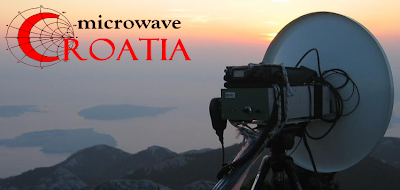NO Tune And Really Small, this time for 13cm band...
After successful testing of NOTARS-C band transverter for the 3400 MHz it was just a matter of time to do the same with the transverter for the S band. It means this transverter can be used on all 13cm bands world wide 2304 MHz, 2320 MHz, 2401 MHz etc... It can be used also as the S53MV NBP ( Non-Flawless Protocol) transverter for up converting the 70cm band to 13 cm or 9 cm ( using the NOTARS-C ) Low side or high side L.O. injection - it does not matter until we use the 70cm band for the I.F.
After successful testing of NOTARS-C band transverter for the 3400 MHz it was just a matter of time to do the same with the transverter for the S band. It means this transverter can be used on all 13cm bands world wide 2304 MHz, 2320 MHz, 2401 MHz etc... It can be used also as the S53MV NBP ( Non-Flawless Protocol) transverter for up converting the 70cm band to 13 cm or 9 cm ( using the NOTARS-C ) Low side or high side L.O. injection - it does not matter until we use the 70cm band for the I.F.
The beer bottle caps are not the part of the project, they are here just to give you the idea of the transverter size. Maybe this beer caps are good for filters up on the 6cm band but not here :-) This is the prof of project board and the final PCB should be even smaller, there is a plenty room for the resizing making everything working the same on less FR-4 substrate. There is a short video showing the reception from the other 13cm transverter using just a Wi-Fi vip antenna.
It can be noted that the frequency stability is quite OK. For the L.O. in the video I am using Si-4133 synthesizer running at 1888 Mhz requiring 432 Mhz for the I.F. for the successfully operation on the 2320 MHz what became a standard in the Europe. For other 13cm band plans scheme just drive the other L.O. frequency. The other side 13cm transverter (transmitting on the video) is using a crystal oscillator with the multiplier to reach the desired L.O. frequency. after a couple of minutes, the stability was also good.
The transmitting part is working also nice, producing more then 18dBm (70mW) of power on 2320 Mhz. This can be enough for rover type operation with the standard Wi-Fi antenna. A small sequencer with the power attenuator and you are ready to go. The on board filters are reducing the unwanted mixer products and L.O. signal almost 50dBc without any external filter. The twins from the picture are ready for the operation. For a moment we will stop here, NOTARS for 5760Mhz is not yet ready.
It can be noted that the frequency stability is quite OK. For the L.O. in the video I am using Si-4133 synthesizer running at 1888 Mhz requiring 432 Mhz for the I.F. for the successfully operation on the 2320 MHz what became a standard in the Europe. For other 13cm band plans scheme just drive the other L.O. frequency. The other side 13cm transverter (transmitting on the video) is using a crystal oscillator with the multiplier to reach the desired L.O. frequency. after a couple of minutes, the stability was also good.
The transmitting part is working also nice, producing more then 18dBm (70mW) of power on 2320 Mhz. This can be enough for rover type operation with the standard Wi-Fi antenna. A small sequencer with the power attenuator and you are ready to go. The on board filters are reducing the unwanted mixer products and L.O. signal almost 50dBc without any external filter. The twins from the picture are ready for the operation. For a moment we will stop here, NOTARS for 5760Mhz is not yet ready.







.JPG)
.JPG)